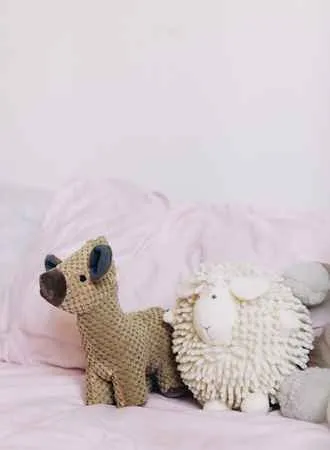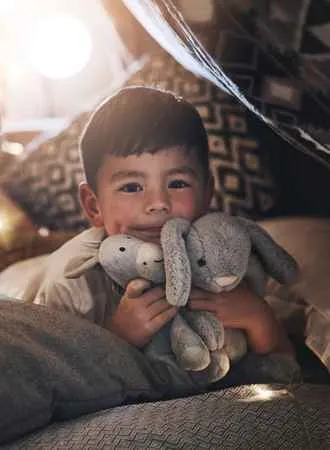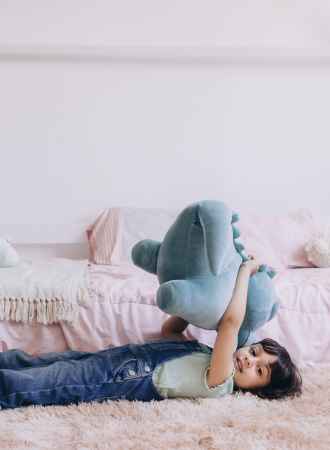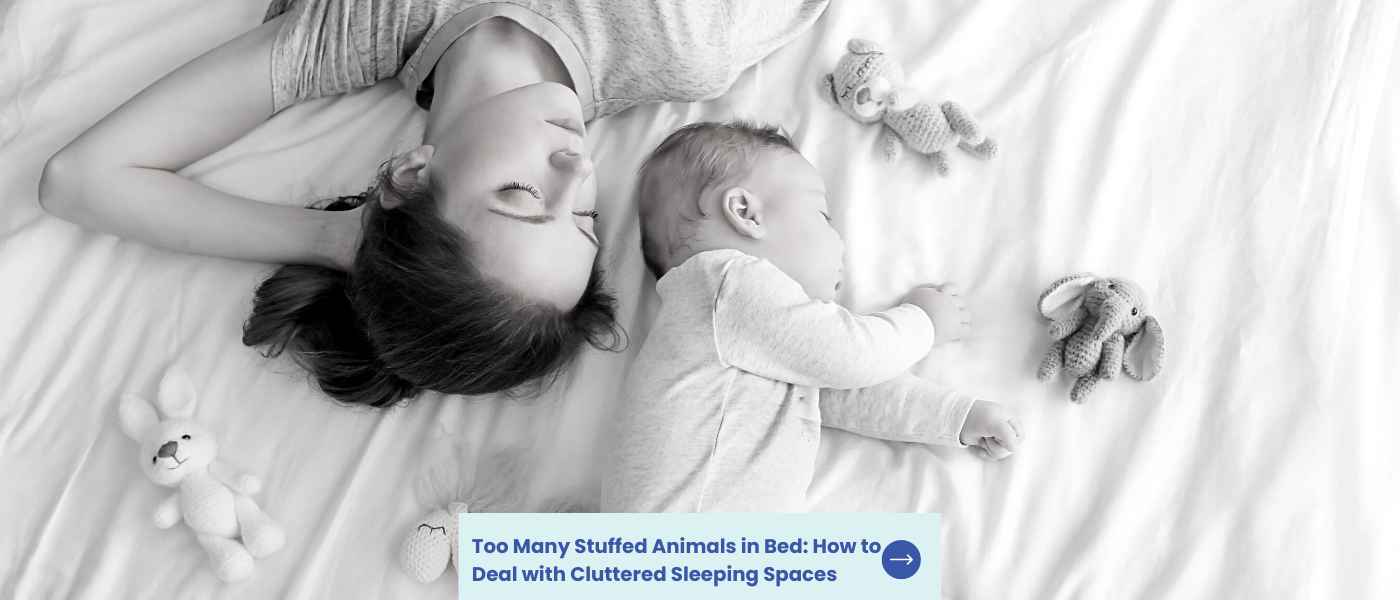Stuffed animals are a staple in many households, especially those with children. These soft and cuddly companions can provide comfort and a sense of security to kids and adults alike. However, when the number of stuffed animals in a room starts to pile up, it can become overwhelming and difficult to manage.
Having too many stuffed animals in bed can lead to the feelings of a cluttered and cramped sleeping space. It can also make it challenging to find a specific stuffed animal when it’s needed. Additionally, as children grow older, they may outgrow their stuffed animals but still hold onto them, leading to even more clutter.
Fortunately, there are several solutions to this problem. From creative storage ideas to decluttering strategies, there are ways to manage the number of stuffed animals in a bedroom. It’s important to find a balance between keeping the stuffed animals that provide comfort and getting rid of those that are no longer needed. In this article, we will explore various ways to handle too many stuffed animals in bed and create a more organized and comfortable sleeping space.
Key Takeaways on Too Many Stuffed Animals
Managing stuffed animals — Solutions for managing stuffed animal overload include rotating them regularly, using storage solutions, donating or giving away excess animals, creating a display area, setting a limit on stuffed animals in bed in the room, maintaining cleanliness and allergen control, and involving children in the decluttering process.
Maintain safe sleep — To minimize allergens and maintain a safe sleep environment, regularly wash plush toys and vacuum the sleeping area frequently; consider hypoallergenic stuffed animals for those with allergies.
Determining stuffed animal quantity — There is no one-size-fits-all answer to how many stuffed animals are too many; consider bed size, age, allergies, and storage space when determining the right number for your space.
The Risks of Too Many Stuffed Animals
Risk of Suffocation
According to the American Academy of Pediatrics, pillow-like soft toys and, blankets, quilts, crib bumpers, and other bedding increase the risk of sudden infant death syndrome (SIDS) and death by suffocation or strangling in infants under the age of six months. While it is less common in older children, the risk of suffocation still exists if there are too many stuffed animals.
When a child is surrounded by too many stuffed animals, it can make it difficult for them to breathe properly. The stuffed animals can also fall on top of the child’s face, blocking their airway and causing suffocation. This risk is especially high for younger children who may not have the strength or coordination to move the stuffed animals away from their face.

Risk of Allergic Reactions
Stuffed animals can collect dust, dirt, and other allergens over time, which can cause an allergic reaction. If a child has too many stuffed toys or animal, it can increase their exposure to these allergens and trigger allergic reaction such as sneezing, coughing, itching, and even asthma attacks.
Plush animals such as a teddy bear attract dust mites, and those cuddly toys and teddy bears can lead to an increase in allergens within your sleeping environment. Over time, this accumulation of dust mites and allergens can trigger symptoms such as sneezing, coughing, itching, watery eyes, and even asthma attacks for individuals with allergies or sensitivities
It is important to regularly wash and clean stuffed animals to reduce the risk of allergic reactions. If a child has a lot of stuffed animals, it may be difficult to keep up with the cleaning and maintenance required to keep them free of allergens.
Risk of Poor Sleep Quality
Too many stuffed animals can also affect a child’s sleep quality. If the bed is overcrowded with stuffed animals, it can make it difficult for the child to find a comfortable position to sleep in.
The stuffed animals can also create a lot of noise and movement, which can disturb the child or baby’s sleep and make it harder for them to fall asleep or stay asleep throughout the night.
It is important to create a comfortable sleep environment for children by limiting the number of stuffed animals in bed. This will help them get better quality sleep and feel more rested and refreshed in the morning.
How Many Stuffed Animals Are Too Many?
There is no one-size-fits-all answer to this question, as it ultimately depends on personal preference and individual circumstances. However, there are a few things to consider when determining how many stuffed animals are too many:
- Bed Size: If the bed is small, having too many stuffed animals can make it difficult to sleep comfortably.
- Age: As children get older, they may outgrow their love for stuffed animals and prefer other types of toys.
- Allergies: If someone in the household has allergies, having too many stuffed animals can exacerbate the issue.
- Storage Space: If there isn’t enough storage space for all the stuffed animals, they can quickly clutter up a room.
Ultimately, the number of stuffed animals in bed should be limited to what is comfortable and practical for the individual. If the bed is overcrowded with stuffed animals, it may be time to consider decluttering and finding alternative storage solutions.

Tips for Managing Stuffed Animal Overload
Rotate Stuffed Animals Regularly
One way to manage stuffed animal overload is to rotate them regularly. This means that you can keep some of them out on display, while others are stored away. This can help to keep your child’s room looking neat and tidy, while also reducing clutter. You can rotate the stuffed animals on a weekly or monthly basis, depending on your child’s preferences.
Use Storage Solutions
Another way to manage stuffed animal overload is to use storage solutions. There are many different storage solutions weighted stuffed animals available, such as baskets, bins, and shelves. You can use these to store the stuffed animals that are not currently in use. This can help to keep your child’s room organized and free from clutter.
Donate or Give Away Excess Stuffed Animals
Consider donating or giving away excess stuffed animals to friends, family, or charitable organizations. This can help declutter your space while bringing joy to others. Ensure the stuffed animals are clean and in good condition before donating or giving them away.
Create a Stuffed Animal “Zoo” or Display Area
Designate a specific area in the room for displaying stuffed animals. This can be a shelf, corner, or even a DIY stuffed animal “zoo” made with bungee cords and a wooden frame. Creating a dedicated space for stuffed animals keeps them organized and prevents them from taking over the bed.
Set a Limit on Stuffed Animals in Bed
Establish a reasonable limit on the number of stuffed animals allowed in bed. Encourage your child to choose their favorites and keep the rest in designated storage areas. This helps create a comfortable and safe sleeping environment while still allowing your child to enjoy their favorite stuffed animals.

Maintain Cleanliness and Allergen Control
To minimize allergens and maintain a clean environment, regularly wash and sanitize the stuffed animals according to their care labels. Vacuum the sleeping area frequently and, if necessary, consider investing in hypoallergenic stuffed animals for children with allergies.
Wash your stuffed toys regularly using hot water or cold water depending on the care instructions. Use mild detergent if necessary.
Involve Your Child in the Decluttering Process
When deciding which stuffed animals to keep, involve your child in the decision-making process. This can help teach them valuable skills such as organization and prioritizing. Make it a fun activity by allowing them to choose which stuffed animals they want to keep and which ones they are willing to part with.
- Discover the secret to a clutter-free sleep zone by rotating, storing, and donating excess stuffed animals, while still enjoying their cuddly companionship.
- Ensure a safe and comfortable sleep environment by setting a reasonable limit on stuffed animals in bed, reducing allergens, and maintaining cleanliness.
- Involve your child in the decluttering process to teach valuable organizational skills and create a cozy, personalized sleeping space.
FAQs for Too Many Stuffed Animals
Is it safe to have too many stuffed animals in the bed?
Humans are social creatures so it’s not surprising that many adults still cling to their childhood soft toys and other transitional objects, especially if they feel lonely.
While having a few stuffed animals in bed can provide comfort and security, having too many may pose risks, such as overheating, breathing difficulties, and allergies. It is especially important to ensure infants and young children have a safe sleep environment, which means keeping their sleeping space clutter-free.

How many stuffed animals are considered too many for a bed?
Hugging or cuddling soft toys or comfort objects can help a child get a good night’s sleep but having too many of them in a child’s bedroom can have an opposite effect.
There is no specific number that applies to everyone, as it depends on factors like bed size, personal comfort, and individual preferences. However, it’s important to ensure that your sleeping area is comfortable and not overly crowded, which could affect your sleep quality.
Can having too many stuffed animals affect sleep quality?
Yes, an overcrowded bed can negatively impact sleep quality by causing discomfort, overheating, or even allergies. Ensure you have enough space to move freely in bed and maintain a comfortable temperature.

What should I do if my child insists on having multiple stuffed animals in bed?
Consider setting a limit on the number of stuffed animals allowed in bed, and encourage your child to choose their favorites. You can also provide a designated space, like a shelf or toy hammock, where your child can keep their stuffed animals close without cluttering the bed.
How can I store excess stuffed animals?
You can store stuffed animals in various ways, such as using storage bins, shelves, toy hammocks, or hanging plush toys in mesh organizers. Rotating the stuffed animals in and out of your child’s bed can also help manage the number of toys in their sleeping space.
How can I ensure my stuffed animals are clean and allergy-free?

Regularly clean and sanitize your stuffed animals by following the care instructions on their labels. Vacuum your sleeping area regularly to reduce dust and allergens. If you or your child suffers from allergies, consider investing in hypoallergenic stuffed animals.
Is it normal for adults to have stuffed animals in bed?
It is not uncommon for adults to have stuffed animals in bed for comfort, companionship, or even as a decorative element. As long as it doesn’t negatively impact your sleep quality or cause any safety concerns, it is perfectly acceptable to have stuffed animals in your bed.
Stuffed animals can help the improve the psychological state of a trauma survivor or people suffering from traumatic experiences.
Can I donate my excess stuffed animals?
Yes, donating excess stuffed animals to charities, hospitals, or other organizations can be a great way to declutter your space while providing comfort and joy to others. Make sure the stuffed animals are clean and in good condition before donating them.




